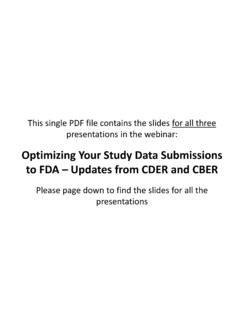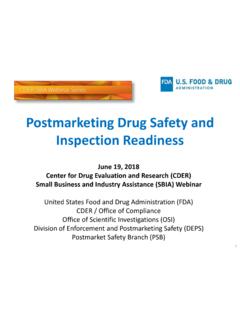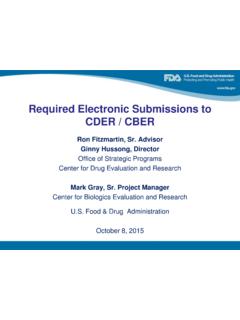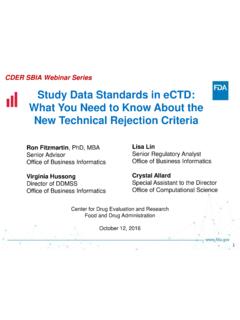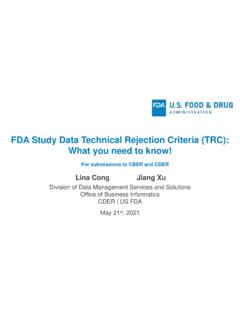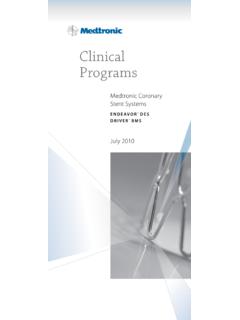Transcription of Writing the Indications and Usage Section
1 Writing the Indications and Usage Section of Labeling: FDA's New Draft Guidance September 27, 2018. Center for Drug Evaluation and Research (CDER). Writing the Indications and Usage Section of Labeling: FDA's New Draft Guidance Iris P. Masucci, PharmD. Special Assistant for Labeling Office of Medical Policy, Center for Drug Evaluation and Research Food and Drug Administration Outline General principles What information to include When to include limitations of use (LOU). How to write, organize, and format the Indications and Usage (I&U) Section 3. FDA Draft Guidance When finalized, will represent FDA's current thinking on this topic Should be viewed only as recommendations, unless specific regulatory or statutory requirements are cited Notes the option of proposing an alternative approach if that approach satisfies requirements of applicable statutes and regulations 4.
2 This FDA Draft Guidance Applies to prescription drugs and biological products regulated as drugs Retains flexibility in presenting Indications Recommends regular communications with FDA staff 5. Indications and Usage Section Enables health care practitioners to readily identify appropriate therapies by clearly communicating the drug's approved indication(s). Should be clear, concise, useful, and informative and, to the extent possible, consistent within and across drug and therapeutic classes 6. Evidentiary Standards for Indications Governed by regulation For drug products, Indications must be supported by substantial evidence of effectiveness based on adequate and well-controlled studies* . ( (c)(2)(iv)). For biological products, Indications must be supported by substantial evidence of effectiveness.
3 ( (c)(2)(v)). * As defined in 21 CFR (b) 7. Scope of an Indication Relative to the Population Studied I&U Section should clearly communicate scope of the approved indication , the population to which the determination of safety and effectiveness is applicable Applicants should discuss scope of a proposed indication with the applicable review division 8. Scope of an Indication Relative to the Population Studied Indication may mirror the studied population ( , in terms of patient demographics or severity of disease), but can sometimes differ In some cases, FDA may conclude that available evidence supports approval of an indication broader or narrower in scope than the precise population studied 9. Broader than Studied An indication for a broader population than was studied may be appropriate after careful consideration of: Generalizability of the evidence Consistencies in the disease process across different groups Drug's overall benefits and risks 10.
4 Broader than Studied Indications may include patient populations that were absent or specifically excluded from clinical studies supporting approval , geriatric patients, pregnant women, patients taking certain concomitant drugs 11. Example of a Broader Indication Trial evaluating a drug in adults enrolled patients of a certain age range and excluded patients taking certain concomitant drugs Available evidence does not suggest drug would be unsafe or ineffective in adults outside that age range or in those taking the other drugs 12. Example of a Broader Indication In this scenario: Indication should be worded to reflect broader age group ( , in adults ), rather than exact ages studied, and Unless available evidence suggests otherwise, indication should not exclude use in patients taking the concomitant drugs 13.
5 Another Example of a Broader Indication Drug was studied only in patients with a moderate stage of a disease There is reason to believe -- based on generalizability of the data, consistencies in disease process, and drug's benefits and risks -- that drug would be safe and effective in a broader group of patients with the condition 14. Another Example of a Broader Indication In this scenario: An indication covering a broader population with the disease may be appropriate In some cases, an indication covering the overall disease population can be considered 15. Example of a Narrower Indication A randomized trial that stratified patients by presence/absence of a specific genomic marker Benefit seen only in patients positive for the marker FDA may conclude that available evidence supports approval of an indication in a population narrower in scope than was studied 16.
6 Indications Matching the Studied Population Some study designs may identify population in which the benefits outweigh the risks or the only population in which effectiveness is reasonably likely In such cases, indication should reflect only the population studied, unless and until evidence is available supporting determination that broader safety and effectiveness can be expected 17. Indications Matching the Studied Population - Examples Prognostic enrichment , enrolls only people with prior myocardial infarction in study of an antiplatelet drug Predictive enrichment , enrolls only people with a specific genomic marker 18. Pediatric Considerations Not appropriate to generalize across pediatric populations or between adult and pediatric populations because of: Unique clinical considerations in children ( , differences in drug metabolism, different safety risks, and need for different dosing regimens).
7 Statutory requirements related to pediatric assessments 19. Inclusion of Age Groups in Indications For these reasons, Indications should state that a drug is approved, for example: in adults . in pediatric patients X years of age and older . in adults and pediatric patients X years of age and older . 20. Other Related Labeling Regulations Indications or uses must not be implied or suggested in other sections of labeling if not included in I&U ( (c)(2)(iv) and (v)). FDA may require specific warning about an unapproved use in Warnings and Precautions if drug is commonly prescribed for that use and if such use has a clinically significant risk or hazard ( (c)(6)(i)). 21. Updating the I&U Section Labeling must be updated when new information becomes available that causes the labeling to be inaccurate, false, or misleading ( (a)(2)).
8 22. Updating the I&U Section Application holders should: Review I&U regularly to ensure it reflects current science and, to extent possible, maintains consistency within a drug class Discuss with FDA staff 23. Content and Format of I&U Section The I&U Section includes: The indication And, as appropriate, any identified limitations of use 24. Details to Include in the Indication For many drugs, indication will be sufficiently conveyed by stating Disease or condition being treated, prevented, mitigated, cured, or diagnosed, and Age group(s). 25. Details to Include in the Indication In such circumstances, endpoints and descriptions of benefit should be summarized in Clinical Studies and should not be included in I&U. 26. Details to Include in the Indication Other scenarios may warrant inclusion of more information in the indication For example: Drug targets a different aspect of a disease ( , in multiple sclerosis).
9 Endpoints are not well-standardized ( , in heart failure). 27. Examples of Endpoints in Indications Drug for the treatment of insomnia Indication should state whether drug affects sleep onset, sleep maintenance, or both Will facilitate appropriate prescribing 28. Examples of Endpoints in Indications Outcome study with overall effect on composite endpoint Indication should identify components of composite ( , cardiovascular death, myocardial infarction, and stroke). 29. Details to Avoid in Indications I&U is not a description of data supporting determination of effectiveness Inclusion of such details could suggest short-term use of a drug indicated for a chronic condition 30. Details to Avoid in Indications Descriptions of the basis for approval , statement that effectiveness was demonstrated in two 12-week trials in patients with FEV1 less than 60% of predicted Discussions of disease definitions , diagnostic criteria for major depressive disorder 31.
10 Components of the Indication Indications should begin with: DRUG-X is indicated . And must include certain elements required under 21 CFR (c)(2)(i). 32. Required Elements Under 21 CFR (c)(2)(i). Disease Treated Condition Prevented or being Mitigated Manifestation of Cured disease or condition or ( , symptoms) Diagnosed 33. Required Elements Under 21 CFR (c)(2)(i). And, when applicable, other information necessary to describe the approved indication 34. Descriptors or Qualifiers Patients previously treated with other therapies ( , hormone-refractory prostate cancer). Patients with a certain classification of a disease ( , WHO Group I pulmonary arterial hypertension). Patients with other important identifying variables ( , immunocompetent patients). 35. Descriptors or Qualifiers DRUG-X is indicated for the treatment of adult and pediatric patients 12 years of age and older with moderate to severe plaque psoriasis who are candidates for phototherapy or systemic therapy.

